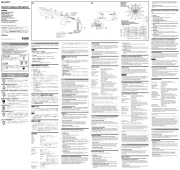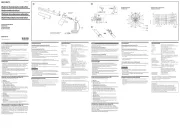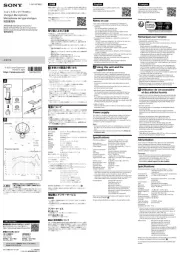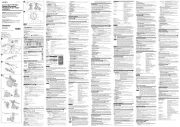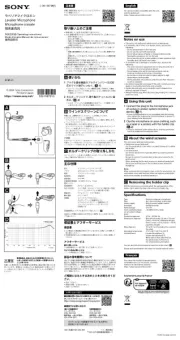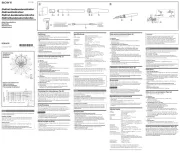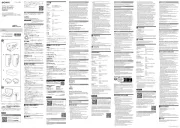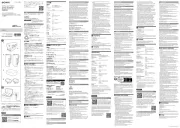
Læs denne vejledning grundigt før brug af mikrofonen. Denne vejledning bør
gemmes til fremtidig reference.
Dette produkt er beregnet til brug i følgende elektromagnetiske miljøer: E1
(bolig), E2 (handel og let industri), E3 (urban udendørs), E4 (kontrolleret
EMC-miljø, f.eks. TV-studie).
Sony Professional Solutions Europe – standardgaranti og undtagelser fra
Besøg https://pro.sony/en_GB/support-services/warranty/support-
professional-solutions-europe-standard-product-warranty for at få vigtige
oplysninger og fuldstændige vilkår og betingelser.
Til videokameraets indgangsstik/
Videokameran tuloliitäntään/
Til videokameraets inngangskontakt/
Till videokamerans ingångskontakt
Lyddesign af høj kvalitet
Kabinetdesign med høj stivhed giver høj lydkvalitet, høj følsomhed og
Super kardioid mikrofon med minimal følsomhed over for omgivende
Mikrofonens skarpe retningsangivelse gør den velegnet til lydoptagelser
på mellemlange afstande, f.eks. på en stationær computer ved konferencer,
udendørs optagelse med smal vinkel eller tilsluttet til et videokamera.
Længde på 250 mm og vægt på 200 g, hvilket gør den nem at bruge og bære.
LOW CUT-kontakt, der reducerer unødvendig lavfrekvent støj
Lavpasfilteret reducerer den støj, der opstår som følge af vind eller
Ekstern strømforsyningstype
Understøtter 40 V til 52 V DC ekstern strømforsyning.
Delenes navne og funktioner (Fig. )
(Tallene henviser til de tilsvarende tal i figuren.)
Lavpasfilteret reducerer effektivt vindstøj.
Lavpasfilteret er anvendt.
Udgangsstik (XLR-3-12C-typen)
Udsender den lyd, der optages af mikrofonen. Den leverer også strøm fra
den eksterne strømforsyning.
-a Mikrofonafstandsstykke (støbt type) /
Mikrofonafstandsstykke (arktype)
Til brug, når du slutter mikrofonen til et videokamera ved hjælp af en
mikrofonholder (leveres sammen med videokameraet eller tilgængeligt
for at mindske støj fra blæst eller vejrtrækning.
Når mikrofonen er monteret, skal du holde mikrofonen i den nederste del
for at fastgøre vindskærmen på
Bruges, når mikrofonen sættes i et mikrofonstativ (medfølger ikke).
Bruges til at tilslutte mikrofonens udgangsstik
(XLR-type) på et videokamera (kabellængde: 500 mm).
Tilslutning til et videokamera (Fig. )
Når mikrofonen monteres på et videokamera ved hjælp af en mikrofonholder
(medfølger ikke), skal du sætte det medfølgende mikrofonafstandsstykke
). Hvis der er problemer med vibrationer
fra videokameraet, skal du bruge mikrofonens afstandsstykke (arktype)
i stedet for. Fjern de to udløserplader (
), og vikl afstandsstykket rundt om
Fastgør mikrofonen til holderen, så "UP"-mærket på mikrofonen vender
opad for at opnå korrekt retning.
Denne mikrofon er kun strømførende fra en ekstern forsyning. Tilslut
til en ekstern strømforsyning, f.eks. en Sony AC-
strømforsyning eller tilsvarende enhed, eller mikrofonstikket på en lydmixer
eller et videokamera. For tilslutning, skal du bruge et mikrofonkabel.
Før du tilslutter mikrofonen til et videokamera eller en anden enhed, skal du
kontrollere, at den er udstyret med et 40 V til 52 V mikrofonindgangsstik.
Et ubalanceret kabel kan ikke anvendes sammen med denne mikrofon. Sørg
for at bruge et afbalanceret mikrofonkabel.
Mikrofoner er følsomme. Undgå at tabe den eller udsætte den for slag eller
Undgå langvarig brug eller opbevaring i høj fugtighed eller temperaturer på
Hvis der opstår akustisk tilbagekobling under brug (en hyletone fra
højttalerne), skal mikrofonen peges væk fra højttalerne eller afstanden
mellem mikrofonen og højttalerne øges.
Type Elektret-kondensatormikrofon
Strømforsyning Ekstern strømforsyning 40 V til 52 V DC
Strømforbrug 4,0 mA eller mindre
Udgangsstik XLR-3-12C-typen
Medfølgende tilbehør Vindskærm (1), mikrofonholder (1),
mikrofonafstandsstykke (2), mikrofonkabel (1),
bæretaske (1) stativadapter (2), brugervejledning
Frekvenskurve 40 Hz til 20.000 Hz
Retningsangivelse Super kardioid
Udgangsimpedans 200 Ω ± 20 % (1 kHz), afbalanceret
Følsomhed (typisk) -28 dB (39,8 mV) (0 dB = 1 V/Pa ved 1 kHz)
Signal til støj-forhold 78 dB (typisk) (IEC 179 A-vægtet, 1 kHz, 1 Pa)
Indbygget støj 16 dB SPL (typisk) (0 dB SPL = 2 x 10
Vindstøj* 60 dB SPL eller mindre
Maksimalt lydtrykniveau for indgang
127 dB SPL (typisk) (inputniveau for 1 %
udgangssignalkurveforvrængning ved 1 kHz,
konverteret til tilsvarende lydtryksniveau: 0 dB SPL
Driftstemperatur 0 °C til 60 °C (32 °F til 140 °F)
Opbevaringstemperatur -20 °C to +60 °C
* Vindstøj er den værdi, der måles ved at anvende en vindhastighed på 2 m/s
på mikrofonen fra alle retninger. Middelværdien for støjniveauet konverteres
til det tilsvarende lydtryksniveau for input (0 dB SPL = 2× 10
Der tages forbehold for ændring af design og specifikationer uden varsel.
Kontrollér altid, at enheden fungerer korrekt, inden brug. SONY ER
IKKE ANSVARLIG FOR SKADER AF NOGEN ART, HERUNDER,
MEN IKKE BEGRÆNSET TIL, ERSTATNING ELLER GODTGØRELSE
I FORBINDELSE MED TAB AF NUVÆRENDE ELLER FORVENTET
INDTJENING, DER SKYLDES FEJL I DENNE ENHED, ENTEN UNDER
GARANTIPERIODEN ELLER EFTER UDLØBET AF GARANTIEN,
ELLER AF EN HVILKEN SOM HELST ANDEN ÅRSAG.
Tutustu tähän oppaaseen perusteellisesti ennen mikrofonin käyttöä. Säilytä
opas tulevaa käyttöä varten.
Euroopassa asuvat asiakkaat
Laite on tarkoitettu käyttöön seuraavissa sähkömagneettisissa ympäristöissä: E1
(asuinympäristö), E2 (liiketilat ja kevyt teollisuus), E3 (ulkotilat kaupungissa)
ja E4 (ympäristössä, jossa valvotaan sähkömagneettista yhteensopivuutta,
Euroopassa asuvat asiakkaat
Sony Professional Solutions Europe - vakiotakuu ja vakiotakuun poikkeukset.
Katso tärkeät tiedot ja täydelliset ehdot osoitteesta https://pro.sony/en_GB/
support-services/warranty/support-professional-solutions-europe-standard-
Erinomainen muotoilu äänenlaadun kannalta
Jämäkkä rakenne ja herkkä mikrofonikapseli takaavat erinomaisen
äänenlaadun ilman kohinaa.
Superherttamikrofoni, jossa on hyvä taustaäänien vaimennus
Kapean suuntakuvionsa ansiosta mikrofoni sopii keskipitkän etäisyyden
äänentallennukseen, kuten tietokoneella konferensseissa, kapean alueen
äänentallennukseen ulkona tai liitettynä videokameraan.
Helppo käyttää ja kuljettaa mukana 250 mm:n pituuden ja 200 gramman
LOW CUT -kytkin rajaa pois tarpeettoman matalataajuisen kohinan
Ylipäästösuodin vähentää tuulesta tai tärinästä johtuvaa kohinaa.
Ulkoisen virtalähteen tyyppi
Tukee 40–52 V:n (DC) ulkoista virtalähdettä.
Osien nimet ja toiminnot (kuva )
(Numerot vastaavat kuvassa olevia numeroita.)
Ylipäästösuodin vähentää tuulen aiheuttamaa kohinaa tehokkaasti.
ylipäästösuodin on käytössä.
Lähtöliitäntä (XLR-3-12C-tyyppinen)
Toistaa mikrofonin tallentamaa ääntä. Käyttää virtaa myös ulkoisesta
-a Mikrofonin välike (valettu) /
-b Mikrofonin välike (levy)
Käytetään, kun mikrofoni kiinnitetään videokameraan käyttäen
mikrofonin pidikettä (toimitettu videokameran mukana tai saatavilla
Vaimenna tuulesta tai hengityksestä johtuva kohina kiinnittämällä
. Kiinnittämisen jälkeen kiinnitä tuulisuoja mikrofoniin
pitämällä mikrofonia tuulisuojan alaosasta
Käytä, kun kiinnität mikrofonia mikrofonitelineeseen (lisävaruste).
Liitä mikrofonin lähtöliitäntä
videokameran tuloliitäntään (XLR-
tyyppinen) (kaapelin pituus: 500 mm).
Liittäminen videokameraan (kuva )
Kun liität mikrofonia videokameraan mikrofonin pidikkeen avulla
(lisävaruste), kiinnitä mukana toimitettu mikrofonin välike (valettu)
). Jos videokamera saattaa aiheuttaa tärinää, käytä mikrofonin
-b. Irrota kaksi irrotuslevyä (
) ja kiedo välike mikrofonin
Varmista oikea suuntakuvio kiinnittämällä mikrofoni pidikkeeseen siten,
että mikrofonissa oleva UP-merkki on ylöspäin.
Tämä mikrofoni saa virtaa vain ulkoisesta lähteestä. Liitä mikrofonin
ulkoiseen virtalähteeseen, kuten Sonyn verkkolaitteeseen tai
vastaavaan, tai äänimikserin tai videokameran mikrofoniliitäntään. Käytä
liittämiseen mikrofonikaapelia.
Varmista ennen mikrofonin liittämistä videokameraan tai muuhun
laitteeseen, että toisessa laitteessa on 40–52 V:n tuloliitäntä mikrofonille.
Tämän mikrofonin kanssa ei voi käyttää tasapainottamatonta kaapelia.
Varmista, että käytät tasapainotettua mikrofonikaapelia.
Käyttöä koskevia huomautuksia
Mikrofonit ovat herkkiä laitteita. Älä pudota tai kolhi sitä tai altista sitä
Vältä pitkäkestoista käyttöä tai säilytystä kosteassa tai yli
60°C:n (140°F:n) lämpötilassa.
Jos käytön aikana ilmenee akustista kiertoa (kaiuttimista kuuluu ulvontaa),
osoita mikrofonia poispäin kaiuttimista tai siirrä mikrofoni kauemmas
Tyyppi Elektriteettikondensaattorimikrofoni
Virtalähde Ulkoinen virtalähde 40–52V DC
Virrankulutus 4,0 mA tai alle
Lähtöliitäntä XLR-3-12C-tyyppinen
Paino Noin 200g (7,1 unssia)
Mukana toimitetut lisävarusteet
Tuulisuoja (1), mikrofonin pidike (1), mikrofonin
välike (2), mikrofonikaapeli (1), kantolaukku (1),
telinesovitin (2), käyttöohjeet (1), takuulehtinen (1)
Taajuusvaste 40 Hz – 20000 Hz
Lähtöimpedanssi 200 Ω ± 20 % (1 kHz), tasapainotettu
Herkkyys (tyypillinen) −28 dB (39,8 mV) (0 dB = 1 V/Pa, 1 kHz)
Signaali-kohinasuhde 78 dB (tyypillinen) (IEC 179 A-painotettu, 1 kHz,
Ominaiskohina 16 dB SPL (tyypillinen) (0 dB SPL = 2 × 10
Tuulen aiheuttama kohina*
Suurin tuloäänen äänenpainetaso
127 dB SPL (tyypillinen) (tulotaso 1 %:n
lähtösignaalin aaltomuodon vääristymälle 1 kHz:n
tasolla muunnettuna vastaavaksi äänenpainetasoksi:
Dynaaminen alue 111 dB (tyypillinen)
Käyttölämpötila 0–60 °C (32–140 °F)
Säilytyslämpötila −20–60 °C (−4–140 °F)
* Tuulen aiheuttama kohina on mitattu suuntaamalla mikrofoniin ilmaa
nopeudella 2 m/s (6,6 jalkaa/s) kaikista suunnista. Kohinan keskiarvo
muunnetaan vastaavaksi tuloäänen äänenpainetasoksi (0 dB SPL = 2× 10
Ulkoasua ja teknisiä ominaisuuksia voidaan muuttaa ilman erillistä ilmoitusta.
Elektret kondensatormikrofon
Elektret-kondensatormikrofon
Elektretkondensatormikrofon
Kurve / Vaste / Respons /
Återgivning
Frekvens / Taajuus / Frekvens / Frekvens
Diagram over frekvenskurve
Frekvensåtergivningsdiagram
Varmista aina ennen laitteen käyttöä, että se toimii oikein. SONY
EI VASTAA MINKÄÄNLAISISTA VAHINGOISTA, MUKAAN
LUKIEN MUUN MUASSA HYVITYKSET TAI KORVAUKSET SIINÄ
TAPAUKSESSA, ETTÄ TÄMÄN LAITTEEN VIKAANTUMINEN
TAI MIKÄ TAHANSA MUU SYY AIHEUTTAA JOKO TAKUUAJAN
KULUESSA TAI TAKUUAJAN UMPEUDUTTUA NYKYISTEN TAI
TULEVIEN TUOTTOJEN MENETYKSEN.
Før du bruker mikrofonen, må du lese denne bruksanvisningen grundig.
Denne bruksanvisningen bør tas vare på for fremtidig bruk.
Dette produktet er ment å brukes i følgende elektromagnetiske miljø: E1
(boliger), E2 (kommersiell og lett industri), E3 (utendørs og urbane miljøer),
E4 (i kontrollerte EMC-miljøer f.eks. et TV-studio).
Sony Professional Solutions Europe – standardgaranti og unntak i
Gå til https://pro.sony/en_GB/support-services/warranty/support-professional-
solutions-europe-standard-product-warranty for viktig informasjon og
fullstendige vilkår og betingelser.
Design for høy lydkvalitet
Robust kabinettdesign for høy lydkvalitet, høy følsomhet og mikrofonkapsel
Superkardiodemikrofon med minimal følsomhet for omgivelsesstøy
Mikrofonens rekkevidde gjør den egnet for opptak av mellomdistanselyd,
for eksempel på en stasjonær datamaskin på konferanser, opptak av smal lyd
utendørs eller tilkobling til et videokamera.
Lengde på 250mm og vekt på 200g, noe som gjør den enkel å bruke og
LOW CUT-bryter som reduserer unødvendig lavfrekvent støy
Lavfrekvensfilteret reduserer støyen som oppstår på grunn av vind eller
Ekstern strømtilførselstype
Støtter ekstern strømtilførsel på 40V til 52V likestrøm.
Delenes navn og funksjoner (figur )
(Tallene samsvarer med numrene i figuren.)
Lavfrekvensfilteret reduserer vindstøy på en effektiv måte.
Aktiverer lavfrekvensfilteret.
Utgangskontakt (XLR-3-12C-type)
Spiller inn lyden som tas opp av mikrofonen. Den forsyner også enheten
med strøm fra den eksterne strømforsyningen.
-a Mikrofonavstandsstykke (støpt type) /
Mikrofonavstandsstykke (filmtype)
Bruk dette når du fester mikrofonen til et videokamera ved hjelp av en
mikrofonholder (følger med videokameraet eller er tilgjengelig separat).
Fest denne til mikrofonen
for å redusere støy fra vind eller pusting.
Når du har festet den til mikrofonen, holder du mikrofonen i den nederste
for å feste vindskjermen til
Bruk denne når du fester mikrofonen til et mikrofonstativ (følger ikke
Bruk denne for å koble utgangskontakten
inngangskontakten (XLR-type) til et videokamera (kabellengde: 500mm).
Festing av enhet til et videokamera (figur )
Når du fester mikrofonen til et videokamera ved hjelp av en mikrofonholder
(følger ikke med), fester du det medfølgende mikrofonavstandsstykket (støpt
). Hvis vibrasjon fra videokameraet kan bli et
problem, bruker du mikrofonavstandsstykket (filmtype)
), og pakk avstandsstykket rundt mikrofongrepet (
Fest mikrofonen til holderen slik at UP-merket på mikrofonen vender
oppover for å få riktig direktivitet.
